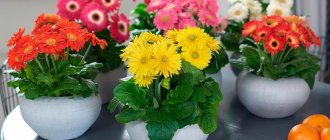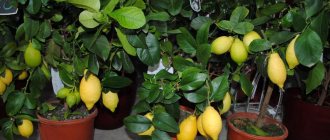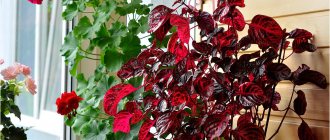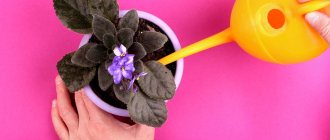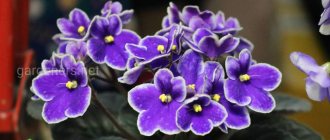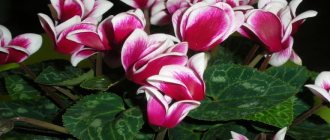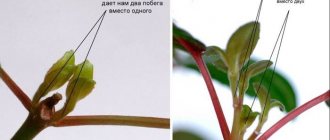- home
- Plant care
>
Azalea Roses Violets Lilies Anthurium Orchid Begonia Fuchsia Croton (codiaum) Palms Gerbera Coffee tree Lemon Cyclamen Aloe Decembrist Caring for potted plants Celosia Narcissus Saintpaulia Fittonia Plumeria Cissus Orange Strobilanthes Boxwood Neomarica
Indoor plants are amazing representatives of the flora. In response to care and careful attitude, they respond with beautiful flowering and delight with elastic green foliage. It doesn’t matter how they came to you: whether they were a gift or purchased, without proper care, houseplants will stop blooming and wither.
There are no trifles in caring for flowers in a pot:
- They are sensitive to room temperature, lighting, humidity and other conditions.
- It is important to water them on time, cut off dry leaves, feed them, and spray them.
The company's specialists urge: be responsible when leaving for a long time on trips or business trips. Even a week's absence of watering or spraying is a test for green “pets”.
We, as a company that has been working in the field of servicing indoor plants for many years, offer flower care services. If individuals or organizations entrust watering, replanting, and fertilizing to our specialists, they can be sure that the service will be provided at a high level.
Rules of care
In winter and summer, caring for indoor plants has its own characteristics:
- Winter is a dormant period for potted flowers. All processes in them slow down, so they need to be watered less often. Feeding is not required at all and the need for a large amount of light (for example, for light-loving varieties) also disappears. But at this time, do not forget to remove dried leaves and monitor whether diseases have appeared.
- With the onset of spring, the flowers “wake up”, begin to bloom, and there is a need for feeding them, frequent watering and spraying. Their service begins to operate as normal.
To make flowers comfortable, it is necessary to create favorable conditions: the desired temperature, humidity and light level.
Rule 4. Pest control
Unfortunately, flowers in pots and cache-pots in the summer are just as susceptible to attack by insect pests as those plants growing in a flower bed. Most often, the inhabitants of containers are affected by spider mites, whiteflies, and aphids, along with their companions - ants. As a preventative measure, we recommend treating flowers 1-2 times during the summer with broad-spectrum insecticides that cope with most flower pests, such as Aktara.
In order not to waste time and immediately detect insects, regularly inspect flowers growing in containers. How can you determine that a plant is affected by insect pests? The main features are as follows:
- the leaves have changed color;
- holes or spots of a color that is not characteristic of this plant have appeared on them;
- the flower begins to dry and wither for no reason (and you follow the watering and fertilizing regime);
- small insects or their larvae appeared on the stems or leaves.
You need to determine who exactly attacked your flowers and immediately begin the fight using targeted insecticides.
- Diseases and pests of annual flowers: how to recognize and fight?
We tell you which annuals are susceptible to diseases and insect attacks and how to save the plants.
Temperature
Beginning gardeners are sure that the warmer the room, the better for the stems and leaves. This opinion has a basis: indoor flowers come from the tropics and their ancestors grew in humid and warm conditions. Despite this, many potted flowers thrive at temperatures up to 24 degrees. Even heat-loving specimens need at least 16 degrees in winter. If 17-18 degrees is not entirely comfortable for a person, then for these plants it is optimal.
The main rules for caring for indoor plants:
- Ensure the temperature in the room where they grow is no more than 24 degrees.
- Avoid temperature differences of more than 6 degrees. If the pot is on the windowsill, then in frosty weather it is better to remove it from there. On a note! Only cacti are not afraid of such changes, because their ancestors grew in deserts, where day and night temperatures differ several times.
- Create a temperature in winter of no more than 13-15 degrees so that your green “pets” experience the rest period they need. So, eucalyptus will thrive even at 5 degrees above zero.
Important! Soil temperature also matters. It is usually a couple of degrees lower than the air temperature, so it is important to protect the flower roots from hypothermia. What to do? Do not place the pot close to the glass when it is cold outside. Another solution is to place the pot on a “mat” made of foam, cork or cardboard.
Indoor violets: care at home
The fundamental principle of caring for indoor violet plants is understanding the natural needs of the plant.
The homeland of the Uzambara beauty is the South African jungle with a tropical climate.
For the well-being of Saintpaulia in the apartment, it is necessary to create conditions close to its natural habitat.
Temperature indicators
Temperature has a significant impact on the development of violets. If the temperature is up to 16ºC, flowering is delayed; at temperatures above +26ºC, the violet blooms quickly and fades just as quickly.
To achieve long and abundant flowering of adult plants, the best indicators are 18-22ºC . At this temperature, the flowers are larger and do not fade for a long time.
The best indicators of active growth of young flowers are 23-24ºC. The plant is developing well and producing buds. It is enough to maintain a temperature in the apartment of 20-22ºC.
A reminder on the temperature regime for violets.
Saintpaulia is a tropical plant; it does not like cold and drafts. You need to ventilate the room with extreme caution so as not to harm the plant. Heat is also not suitable for it ; at 30-40ºC, the plant begins to wither and may die.
Attention! It is important to protect the violet from temperature changes so that the plant is as comfortable as possible in the apartment.
Ambient humidity
High humidity is another parameter of the violet’s natural habitat. In nature this figure reaches 50-60% , in an apartment it is much lower. An air humidifier is a good solution, but not every home has this household appliance. There are alternative ways.
Humidify the air by placing pebbles, expanded clay on a tray, using wet peat or moss. You can place vessels with water on the windowsill and radiators; this will also significantly improve the microclimate near the plants.
For violets, it is important to maintain optimal air humidity.
Another interesting and convenient solution is to use a super-absorbent napkin . Cover the tray with a moistened napkin, and place pots of flowers on top.
But you shouldn’t get too carried away with hydration; there should be moderation in everything. No need to spray the flower with a spray bottle ; in the case of Saintpaulia, this is not effective. An excess of moisture is fraught with the development of rot and fungal diseases for the plant.
Location
Uzambara violets are heat-loving plants, so it is better to place them in the warmest rooms of the apartment.
The most suitable place in the apartment is the kitchen. This room usually has high humidity and heat. In addition, the presence of Saintpaulia will also be useful, since it absorbs carbon dioxide, the concentration of which in the kitchen increases when using a gas stove.
Violet loves bright light, but she needs it not direct, but diffused. It is preferable to place it on northern, eastern or western window sills.
If, however, the plant is placed on the south side, it is necessary to shade the window with a protective film or curtain so that the light is diffused.
Attention! When choosing the location of Saintpaulia, you need to remember that it does not tolerate drafts. From the cold air flow, spots appear on the leaves, and the appearance of the violet is disfigured. From hypothermia, the root system rots, which leads to the death of the plant.
Solar and artificial lighting
The determining factor for violet flowering is light. For an intense and long-lasting process, the plant requires at least 10-12 hours of bright, diffused sunlight. The rest of the time the plant needs to rest in the dark. Rest is very important for violets, since in the dark the hormone responsible for the formation of buds is activated.
The correct amount of light can be determined by the appearance of the plant:
- with insufficient lighting, Saintpaulia leaves become dark and thin, and the stems become elongated;
- if the leaves are light and the stems are short, there is an excess of light. In both cases, the violet will not bloom.
Using only natural, sunlight, it is difficult to achieve long-term flowering. Therefore, flower growers organize additional artificial lighting. The most suitable are fluorescent and LED lamps. You can use a mirror or foil as a reflector; they will help diffuse the light better.
Additional illumination of violets with fluorescent lamps.
Watering
Violet is a delicate plant, very sensitive to watering. Watering from above does not suit her. Water getting into the center of the outlet provokes rotting. There are several methods of watering:
- into the pan - pour water for 20 minutes, after which the excess is drained;
- top - watering at the root or along the edge of the pot. To do this, use a watering can with a thin spout or a syringe;
- drip - watering using a syringe without a needle;
- immersion method - a pot with a flower is immersed for 10-15 minutes in a container of water so that water gets on the leaves;
- wick method - use a wick, one end is lowered into a bowl of water, the other into a drainage hole. The pot is placed on top of the container.
Wick
Wick watering is an ideal method for Saintpaulia, solving several problems at once:
- provides the necessary air humidity;
- creates optimal conditions for more lush, vibrant flowering;
- facilitates plant care;
- makes it possible to leave Saintpaulia for a long time unattended;
- When properly organized, it eliminates waterlogging;
- the plant independently nourishes as much moisture as it needs, depending on environmental factors: seasonality, air humidity, lighting;
- the concentration of mineral fertilizers is reduced by half; with wick watering, the components reach the plant faster.
Carefully! When using the wick method, you need to carefully monitor the water temperature in winter, avoiding hypothermia. The wick should not be made too thick to prevent excess moisture.
During the cold season
With the onset of cold weather, the heating is turned on in apartments, which causes the air to become dry. The soil in pots dries out, but do not increase the frequency of watering. Thorough air humidification is more effective
It must be remembered that in winter the work of the root system is slowed down , moisture is absorbed in slow motion. Therefore, watering should be less intense.
When using the immersion method or watering through a tray, it is not necessary to allow complete penetration of moisture into the ground. The top layer of soil must remain dry. also worth halving the dosage of fertilizer and the frequency of fertilizing.
In winter, watering violets is significantly reduced.
Use water no higher than room temperature . To avoid rotting of the roots, in case of flooding, the violet must be carefully removed from the pot and the earthen lump should be allowed to dry, and then the plant should be returned to the pot.
Water requirements
Several sources of water are used for irrigation
- boiled;
- rain;
- melting;
- enriched;
- from a reservoir;
- from the water supply.
Water from the tap should be taken that has been settled , in which lime and salts settle to the bottom, and chlorine disappears.
Water that is too hard or highly chlorinated must be passed through a filter using a softener cartridge.
Once a month you can water Saintpaulia with boiled water acidified with citric acid .
In winter, you can use melt water , it contains a minimum content of salts and harmful acids.
Rainwater should be taken from heavy, prolonged rains. Since water formed from short-term rains in industrial areas may contain toxic substances.
Once a week it would be good to pamper the Uzambara beauty with water enriched with silver ions. To make such water, just immerse a silver object in it for 15-20 minutes.
Spring water is the ideal choice.
Important! To prevent the plant from getting shock, water should be taken at the same temperature - room temperature.
Top dressing
In spring and summer, Saintpaulia begins to actively grow and form buds. At this time she needs feeding. For good green growth, a young plant needs nitrogen.
After the buds appear, nitrogen-containing fertilizers are not used and are replaced by phosphorus-potassium fertilizers for generous and long-lasting flowering.
Complex mineral fertilizers that contain all the necessary microelements are very convenient to use.
Ready-made complex fertilizers are much easier to use.
Fertilizing is applied twice a month , with the exception of the first time after transplantation and the presence of pests. You can prepare the fertilizer yourself using folk remedies:
- tea;
- coffee grounds;
- sugar;
- or buy a ready-made solution in the store.
You can restore weakened or diseased plants using the preparations Zircon and Domotsvet . Leaves are sprayed generously with the solution.
To root young plants and rejuvenate adult plants, the drugs Radifarm and Teklamin .
You can increase the resistance of plants to unfavorable environmental factors by spraying the leaves with Succinic acid or Immunocytropht.
Soil composition
Self-cooking
Saintpaulia is a plant that is demanding on the composition of the soil. Main components of the soil mixture :
- universal or nutritious soil, humus, peat soil - the basis ;
- peat, fallen pine needles, moss filler act as an antiseptic.
- perlite and sand - leavening agents ;
- hydromica – retains moisture , breathes, prevents plant rotting;
- charcoal – regulates humidity ;
- expanded clay – drainage layer ;
- crushed eggshells and wood ash are a source of phosphorus and nitrogen .
violet soil in a store or prepare it yourself . It can be a simple substrate or a complex mixture.
The main thing is that before preparing the earthen mixture, all components that may contain pest larvae or eggs must be subjected to heat treatment :
- heat in the oven, microwave;
- pour boiling water over;
- steam.
The composition of the soil should be loose, light and airy, and retain moisture well. The plant thrives in slightly acidic soil, so the substrate should be based on peat.
How to test acidity at home?
You can check the acidity of the soil yourself. To do this, sprinkle a pinch of baking soda on a small amount of moistened soil. A reaction with the release of gas bubbles indicates the acidity of the soil. Dolomite flour will help reduce it.
The acidity of the soil will be accurately determined by litmus paper.
Light mode
Caring for house plants also means creating the right level of lighting. Two criteria are important in it: intensity and duration.
- In spring and summer, during the period of active growth, flowers should be illuminated for at least 16 hours a day. If flowers constantly experience a lack of light (this is possible even with a lighting duration of 10 hours or less), then the synthesis of nutrients in them will slow down.
- To provide intense lighting, you need to place pots in rooms with southern, western or eastern windows, and avoid placing them in the corners of the room. If the room has windows facing north, lighting is required. Without it, only ferns, ivy, and cyclamen can grow successfully.
- Flowering specimens need more light.
- Being under direct sunny windows is harmful for indoor “pets”. If the windows face south and the pots are on the windowsill, then according to the rules for caring for indoor flowers, it is necessary to reduce the light intensity by attaching paper to the glass or hanging a transparent curtain.
As part of this, we not only take care of the flowers, but also give recommendations on adjusting the light intensity, on the correct placement of pots within the room, taking into account the requirements of a particular type of plant for the level of illumination.
Rule 3. Trimming
Another important point in the summer care of flowers in pots and cache-pots is pruning. With a lack of moisture or nutrition, as well as at excessively high temperatures, the leaves begin to turn yellow and dry out. They need to be removed regularly to maintain the attractive appearance of the plant.
It is also necessary to remove all wilted inflorescences in a timely manner. Firstly, the plant will look neater without them. And secondly, if you leave the inflorescence, the seeds will begin to ripen in it. The flower (as intended by nature) will begin to spend its energy on this process, and not on flowering, so it will become less abundant.
Pruning is also necessary to form a compact and decorative shape. In addition, when growing several types of flowers in one pot, it is necessary to restrain the growth of the most “active” one - this is also done by pruning. Otherwise, it will take away nutrition and take up the entire space of the container, leaving no room for neighboring plants to grow.
Air humidity
Caring for indoor flowers in low humidity conditions is difficult. Even abundant watering will not give results: the plant will drop its buds and stop growing. To increase humidity, we recommend using several methods:
- Install a humidifier.
- Spray regularly (during the growth period this can be done both in the morning and in the evening). This care should be carried out before the first rays of the sun fall on the pot.
- Use a tray with water.
- Cover heating radiators with wet towels (the method is effective if flower pots are on the windowsill directly above the radiators).
When servicing flowers, the main thing is not to overdo it, because excess moisture in the air (especially in combination with low temperature) is fraught with another problem - rotting.
Secrets of growing flowers from seeds
Begonia and cactus seeds are sown without pre-soaking.
- Names of indoor plants
Soaking is carried out in this way: the seeds are wrapped in a bandage and immersed in clean, soft water for a day or three. The water needs to be changed after five to six hours.
A certain temperature is required for the growth and development of seedlings. Cold-resistant plants need a temperature of about +18ºC, and tropical plants +28-30ºC.
When the first 2-3 leaves appear on the seedlings, the plants should be planted in separate pots.
Feeding indoor plants
Providing flowers with enough nutrients is another important task in their maintenance. In winter they do not need feeding, but in the spring and summer months it is recommended to use mineral fertilizers at least 3 times:
- in the spring, when the dormant period has ended;
- before the formation of buds;
- after flowering is complete.
will take care of all the care of potted plants. We work with organizations and individuals. To view prices for services or get advice, call us by phone.
Prices for plant care.
| Plant care (for organizations) | Things | Cost of service per month | Note |
| Height up to 70 cm. | 1 | 450 rub. | The price includes all necessary procedures and medications |
| Height up to 1.5 meters | 1 | 550 rub. | |
| Height up to 2.5 meters | 1 | 750 rub. | |
| Height from 2.5 meters | 1 | 1,000 rub. | |
| A discount is provided based on the number of plants served | |||
All prices include VAT.
Leave a request for services
your name
Telephone
By submitting data I accept the terms of the user agreement
Send
Pests
The likelihood of pest infestation of indoor plants is highest during the summer months. However, you should regularly inspect your home garden all year round.
At the first signs of infection, you should isolate the plant from its fellow plants and remove pests from it. Special care and treatment with special means continue until complete recovery.
For methods of protecting indoor plants from pests, watch the video:
[youtube https://www.youtube.com/watch?v=UXdPBWWCKc4&w=700&h=395]
Reviews
Natalia, 25 years old
I really love being surrounded by living plants. Renting at home is much more comfortable. But as soon as I think about the planned fertilization and replanting, panic begins. I am very glad that I can only enjoy the beauty of indoor plants, and entrust their care to professionals from. All manipulations with my green “friends” are performed simply masterfully – as quickly and efficiently as possible!
Evgeniya, 43 years old
Just recently, all the finishing work in the house was completed, and that long-awaited moment came when I was able to direct all my efforts to improving the yard. I thought that, armed with advice from the Internet, I could quickly cope with this task. It turned out that landscaping requires deep knowledge and specialized equipment. I didn’t dare to ruin my dream of an ideal courtyard, so I started creating it. Thank you very much for the work done!
Tatyana, 58 years old
I have a fairly large house and every room is surrounded by decorative flowers. Every year it becomes more and more difficult to care for them, especially since my collection is constantly replenished with new specimens. So that many years of efforts would not be in vain, I decided to ask for help. A friend recommended visiting the website serissa.ru. I was pleasantly surprised by the variety of the company's services and its affordable prices. Now I don't have to worry about my flowers losing their attractiveness.
You can find a complete list of reviews in the reviews section.



